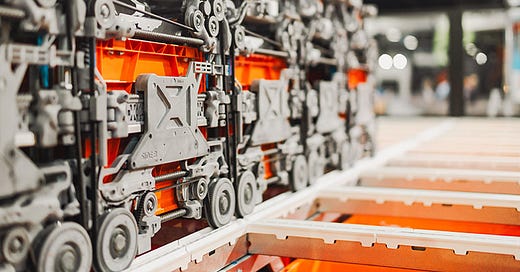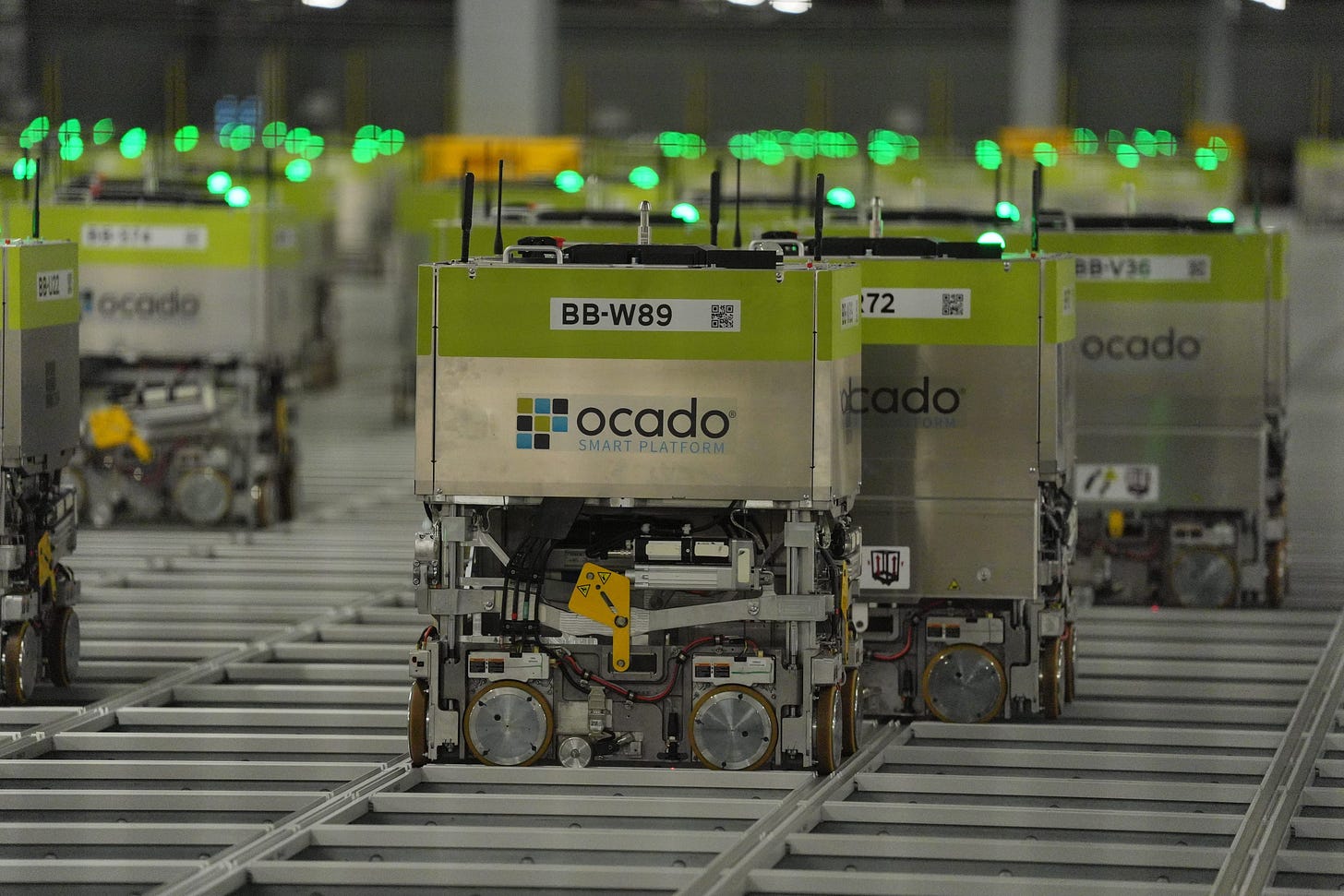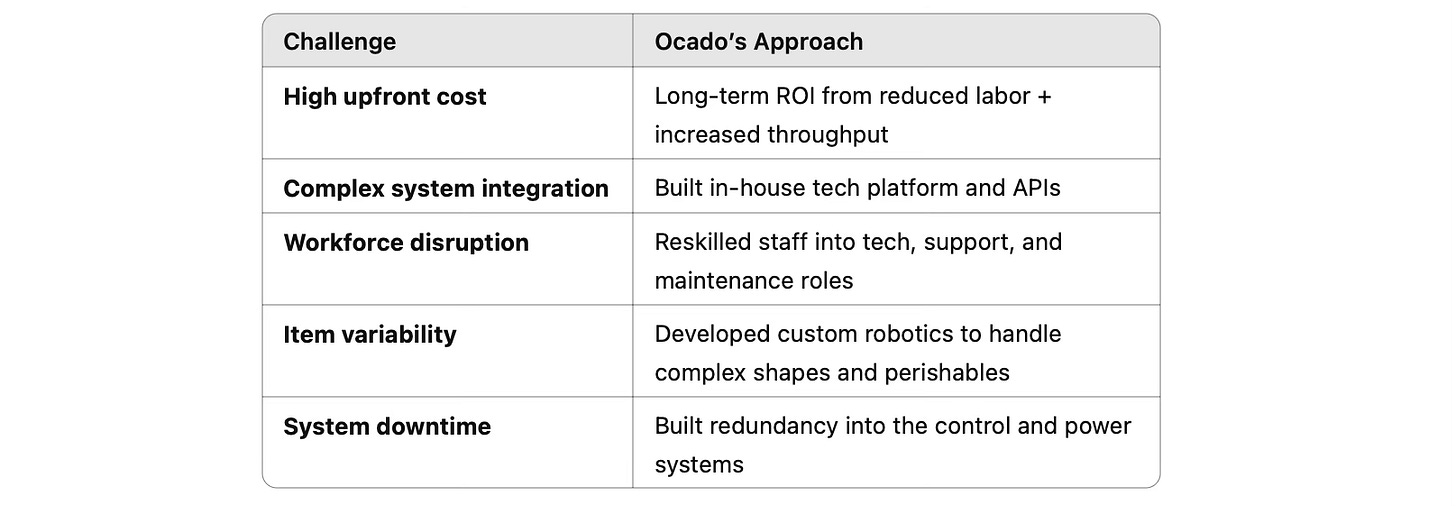Inside Ocado: How AI and Robotics Are Redefining Grocery Fulfillment
From Hive Robots to RaaS: What Supply Chain Leaders Can Learn From Ocado’s Fully Automated Fulfillment Model
Revolutionizing the Future of Grocery Logistics
In the digital age of logistics, where e-commerce speed and accuracy define customer loyalty, Ocado stands out not just as a retailer, but as a technology pioneer. This British online-only supermarket has reimagined the concept of grocery fulfillment, transforming warehouses into intelligent, automated hives where robots and algorithms do the heavy lifting.
As platforms like FreightAmigo push forward the digitization of freight and end-to-end logistics, Ocado’s innovation offers more than inspiration - it offers a glimpse into what the next generation of fulfillment infrastructure could look like across sectors.
🔍 How Ocado’s Automated Fulfillment Center Works
Ocado’s fulfillment centers, dubbed “hives,” are not traditional warehouses. They are data-driven, robot-powered ecosystems engineered for speed, precision, and scalability. Let’s explore the core components:
1. The 3D Grid (“The Hive”)
A multi-story, modular framework where bins holding grocery items are stacked in columns. This cube-like grid is the storage brain.
2. Swarm Robotics on the Grid
Hundreds of autonomous robots race across the top layer at 4 m/s, navigating the hive using AI to pick up bins and transport them to picking stations. Each robot can retrieve any product in under 5 minutes.
3. AI-Driven Traffic Management
A proprietary control system coordinates robot movement in real time, preventing collisions and optimizing delivery paths - essentially air traffic control for bots.
4. Human & Robotic Picking Stations
Bins are delivered to stations where products are packed into orders - either by humans or robotic arms - depending on product complexity.
5. Automated Bagging and Dispatching
After packing, the orders are bagged and sorted into delivery routes, using algorithmic logic to preserve product integrity (e.g. frozen vs. fragile items).
📈 Why Ocado’s Model Is a Game-Changer
✅ Speed & Accuracy
Orders can be fulfilled in 5 minutes - including up to 50 items per order - with an error rate <1%.
✅ Space Efficiency
The vertical, high-density grid model significantly reduces warehouse footprint while increasing SKU storage.
✅ Scalability
Each robot, bin, and grid module can be added independently, enabling on-demand scaling.
✅ Cost Optimization Over Time
Though capital intensive to build, the system dramatically lowers operational costs, labor, and picking errors over time.
🤖 The Rise of Robotics-as-a-Service (RaaS)
While Ocado owns and operates its tech stack, RaaS is rapidly democratizing warehouse robotics. Businesses can now rent advanced robotics solutions on a subscription basis - reducing CapEx and unlocking access to:
AI-driven mobile robots
Autonomous sorting and picking arms
Cloud-based warehouse orchestration platforms
Benefits of RaaS for SMEs and 3PLs:
Low upfront cost, faster ROI
Pay-per-use scalability
Tech updates and maintenance included
Flexible integration with existing systems
RaaS is poised to become the “cloud computing” moment for warehousing: scalable, accessible, and intelligent.
⚠️ Challenges in Automation—and How Ocado Overcame Them
🌍 Industry Impact: Ocado’s Broader Influence
Ocado’s innovations don’t just serve their own operations. They’ve sold their platform to global retailers like Kroger (USA) and Casino (France), and are reshaping expectations in:
Customer Delivery Speed: Same-day or next-day is becoming standard.
Store Formats: Micro-fulfillment centers and dark stores are emerging.
Retail Tech Investment: Legacy retailers are now investing in AI and robotics to keep up.
Data-Driven Supply Chains: Real-time inventory visibility and predictive restocking are becoming a baseline.
🌐 FreightAmigo’s Role in the Automated Fulfillment Ecosystem
Just as Ocado optimizes warehouse operations, FreightAmigo optimizes what happens after the warehouse - from dispatch to international delivery. Here’s how:
🔗 Integrated Freight Booking
Connects directly to sea, air, rail, road freight - matched in real-time to order output.
📦 Automated Documentation
Generates airway bills, commercial invoices, and customs forms with no manual intervention.
📲 Multi-modal Tracking
Connects warehouse automation with last-mile tracking for full visibility across >1,000 carriers.
🔐 Customs Clearance & Cargo Insurance
Seamlessly bundled into the logistics flow, reducing compliance friction.
👨💻 24/7 Expert Support
Automation doesn’t replace human insight - our logistics experts provide fallback support when needed.
🔮 The Future of Fulfillment: 5 Trends to Watch
AI-Powered Predictive Fulfillment
AI models that anticipate orders and pre-stage inventory closer to expected demand zones.
Fully Autonomous Chain
From robot picking to drone delivery or autonomous EV fleets - complete automation is the endgame.
Urban Micro-Fulfillment
Small robotic hubs placed in city centers to meet 1-hour delivery promises.
Robotics in Non-Grocery Sectors
Electronics, apparel, pharma - Ocado-style automation will expand beyond groceries.
Sustainability by Design
Automated systems that optimize packaging, reduce emissions, and minimize food waste.
🏁 Final Thoughts: A Blueprint for the Smart Supply Chain
Ocado didn’t just build a warehouse - they redefined how physical goods are stored, picked, and delivered in the 21st century. For logistics innovators, warehouse operators, and tech-forward retailers, their story is both a benchmark and a call to action.
Platforms like FreightAmigo are building the connective tissue between automated warehouses and global delivery infrastructure. As we bridge robotics with freight, APIs with shipping docks, and AI with real-time data - we’re not just delivering goods, we’re delivering the future.






